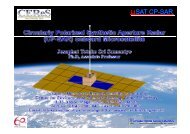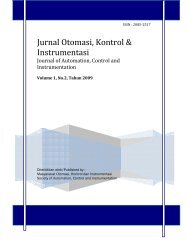Agilent 85070E Dielectric Probe Kit 200 MHz to 50 GHz
Agilent 85070E Dielectric Probe Kit 200 MHz to 50 GHz
Agilent 85070E Dielectric Probe Kit 200 MHz to 50 GHz
You also want an ePaper? Increase the reach of your titles
YUMPU automatically turns print PDFs into web optimized ePapers that Google loves.
Performance CharacteristicsSpecifications describe the warrantedperformance over the temperaturerange 0 <strong>to</strong> 55 °C. Supplementalcharacteristics are intended <strong>to</strong> provideinformation useful in applying theinstrument, by giving typical butnon-warranted performance parameters.These are denoted as “typical,”“nominal,” or “approximate.”<strong>Probe</strong> Characteristics TablePerformance <strong>Probe</strong> Slim Form <strong>Probe</strong> High Temperature <strong>Probe</strong>Frequency Range <strong>50</strong>0 <strong>MHz</strong> <strong>to</strong> <strong>50</strong> <strong>GHz</strong> <strong>50</strong>0 <strong>MHz</strong> <strong>to</strong> <strong>50</strong><strong>GHz</strong> <strong>200</strong> <strong>MHz</strong> <strong>to</strong> 20 <strong>GHz</strong> with network analyzer(nominal) Maximum limited by MUT properties Maximum limited by MUT properties(285-j125)<strong>GHz</strong> (285-j125)<strong>GHz</strong> 10 <strong>MHz</strong> <strong>to</strong> 3 <strong>GHz</strong> with E4991A Impedance 0.05 tangent > 0.05 tangent > 0.05Not recommended for low loss Not recommended for low loss Not recommended for low loss(loss tangent < 0.5) materials (loss tangent < 0.5) materials (loss tangent < 0.5) materialswith e’ > 5 with e’ > 5 with er’ > 5Accuracy (typical) 1 <strong>Dielectric</strong> constant, e r’ = e r’ <strong>Dielectric</strong> constant, e r’ = e r’ <strong>Dielectric</strong> constant, e r’ = e r’±0.05|e r*|. e r”= e r”±0.05|e r*| ±0.05|e r*|. e r”= e r”±0.05|e r*| ±0.05|e r*|. e r”= e r”±0.05|e r*|1. Practical frequency range, accuracy and resolution depend on properties of the MUT. Value indicates typical accuracy at 23 ±3 °C, not includingeffects of probe contact and cable flexure.2. If the material is not homogeneous, the result is an average value weighted by the intensity of the E-field, which is highest at the center conduc<strong>to</strong>rof the probe tip.3. Sample must be as flat as the probe face, which is lapped <strong>to</strong> ±100 µ inches.4. Measurement repeatability for granular materials is dependent on density variation.8






